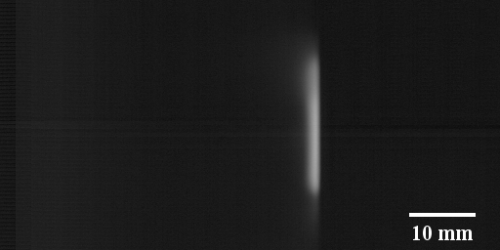Hot lithium vapors shield fusion facility walls

Recent experiments provide the first assessment of the toughness of a novel lithium coating in the face of intense bombardment by very hot plasma in the divertor region of fusion devices. The results show that this coating can shield the divertor region, which vents plasma exhaust, for 10 times longer than previously expected.
If confirmed by further research, this type of lithium treatment could alleviate widespread concerns that liquid-lithium plasma-facing components will rapidly overwhelm the core of the plasma with impurities and abort fusion reactions.
Researchers at the U.S. Department of Energy's Princeton Plasma Physics Laboratory (PPPL) and the Dutch Institute for Fundamental Energy Research (DIFFER) conditioned the target samples with lithium and, in the course of experiments, raised the surface temperature above 900 degrees Celsius. At such high temperatures the lithium rapidly ablates, or wears away, from the target through a combination of evaporation and other erosion processes. The vaporized lithium is expected to serve as a shield that will intercept and mitigate the intense plasma flux before it can impinge upon the rest of the wall.
These experiments demonstrated that such a vapor cloud could be produced and was stable over a wide temperature range. The research found that the regime persisted for three-to-four seconds under the intense plasma bombardment. This indicated that nearly 100 percent of any eroded wall material had been confined to the surface of the sample.
Simple estimates had suggested that coatings without such high confinement at the target could last less than half a second under the intense conditions and would fail to keep impurities from drifting into other parts of the machine.
These initial experiments, performed on the Magnum-PSI linear plasma device at the Dutch center, were done in support of a research and development program planned for the National Spherical Torus Experiment-Upgrade (NSTX-U) at PPPL. The Magnum-PSI plasma served as a proxy for the hot plasma exhaust that the divertor region will channel away in the NSTX-U and other current and future fusion facilities. The researchers used a lithium evaporator developed at PPPL to test the novel vapor-shielded regime on different target materials.
This research indicates that modest coatings of lithium on metallic substrates such as tungsten can be sufficient for initial experiments of the regime in a tokamak such as NSTX-U. Demonstration of the vapor-shielded regime in the NSTX-U would provide proof-of-principle for using liquid lithium as a divertor target material in a reactorrelevant device.
More information: Abstracts:
JO4.00014 Erosion and re-deposition of lithium coatings on graphite and TZM
molybdenum in support of NSTX-U divertor operations (T. Abrams)
Session JO4: NSTX-U and Pegasus
2:00 PM-5:00 PM, Tuesday, November 12, 2013
Room: Plaza D
NP8.00005 NSTX-U Research Goals and Plans for Materials and Plasma-Facing
Components (R. Kaita)
NP8.00006 High-temperature, liquid lithium plasma-facing component research for NSTX-U and next-step devices (M. Jaworski)
Session NP8: Poster Session V: NSTX-U, Advanced Ignition, Laser-Plasma
Interaction and Instability, X-Ray-Laser Sources, ICF, Atomic, Basic
and Partially Ionized
9:30 AM-9:30 AM, Wednesday
Provided by American Physical Society











.jpg)









